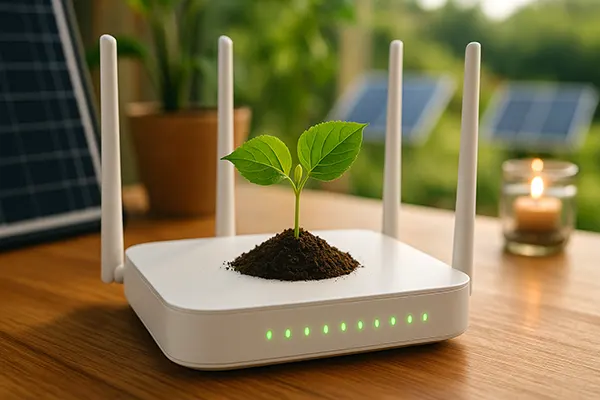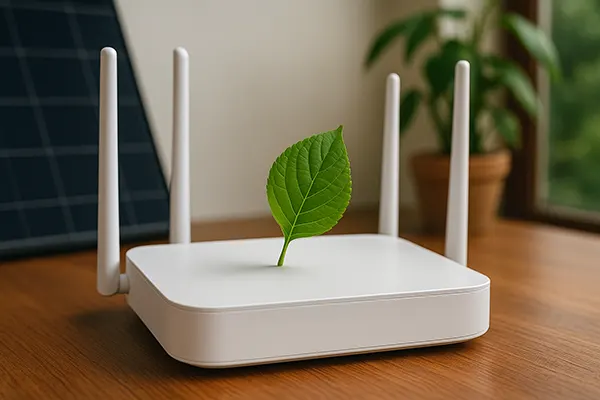Energy Efficiency of Network Equipment: Reducing the Carbon Footprint of Home Internet

The global digital infrastructure continues to expand, and with it grows the energy demand of home internet networks. Routers, modems, switches and Wi-Fi extenders are often overlooked when assessing household energy consumption, yet they operate continuously. Understanding how to improve the energy efficiency of such equipment is essential for lowering both electricity costs and environmental impact in 2025.
Understanding Energy Consumption in Home Networks
Most household network devices are powered on 24/7, even during periods of inactivity. This constant operation leads to unnecessary energy waste, especially in homes equipped with multiple smart devices, streaming services, and IoT systems. Each connected device contributes to the total power load and indirectly increases CO₂ emissions associated with electricity production.
Modern routers and modems vary widely in their energy consumption. Older models can use up to three times more electricity than newer, energy-certified devices. According to the International Energy Agency, replacing outdated networking hardware with modern, efficient alternatives could cut household internet energy use by up to 40%.
Another factor is network configuration. Devices running with outdated firmware or at full transmission power unnecessarily consume more energy. Adjusting bandwidth settings and enabling power-saving modes can provide immediate results without affecting connection stability.
How Energy-Efficient Designs Make a Difference
Recent advancements in chip design and power management have significantly improved router efficiency. Energy-efficient chipsets reduce idle consumption and dynamically manage performance based on traffic demand. Some routers now feature intelligent sleep modes, automatically lowering power use during inactivity periods.
Manufacturers are also adopting renewable materials and recyclable packaging to reduce production-related emissions. Moreover, the European Union’s “Ecodesign Directive” sets efficiency standards for network devices, pushing the industry toward greener practices.
Users can identify efficient equipment through certifications like ENERGY STAR or EU Energy Label. These products meet strict efficiency criteria and can reduce annual household electricity costs by up to 15% when used with optimised network configurations.
Practical Steps to Lower Home Internet Energy Use
Simple behavioural adjustments can have measurable effects. For instance, switching off Wi-Fi at night or when away from home can save up to 30 kWh per year. Using smart plugs allows automated control, ensuring that equipment operates only when needed. This approach not only reduces emissions but also extends device lifespan.
Another practical step involves limiting redundant devices. Instead of multiple repeaters or extenders, consider using a mesh network system. Mesh routers are designed for energy efficiency, distributing data intelligently while consuming less power overall.
Updating router firmware is equally important. Manufacturers regularly release updates that optimise performance and improve power regulation. Enabling energy-saving settings in firmware can further minimise idle consumption without compromising internet speed.
Adopting Renewable Energy for Home Connectivity
Integrating renewable energy sources into household systems adds another layer of sustainability. Solar panels or small-scale wind solutions can offset the electricity consumed by home internet infrastructure. Many households in Europe are already connecting routers and smart hubs to renewable microgrids, significantly reducing dependency on non-renewable power.
Internet providers are also taking steps toward greener operations by using renewable energy in their data centres and local distribution networks. Consumers can support this shift by choosing providers that disclose sustainability reports and use 100% renewable power for their infrastructure.
As the number of connected devices continues to rise, combining energy-efficient hardware with clean energy sources will become an essential strategy for sustainable digital living.

Future of Sustainable Network Technologies
The future of network equipment will focus heavily on automation and AI-driven power management. By analysing user behaviour, future routers will automatically balance performance and energy use, adapting to real-time demand without manual configuration. This will make home networks more intelligent and environmentally friendly.
Developers are also exploring biodegradable components and modular routers, allowing easier repairs and upgrades without replacing entire units. Such modularity could significantly reduce electronic waste, a growing environmental challenge in 2025.
In parallel, global policies on sustainability continue to evolve. Governments and international organisations are investing in research on low-power network infrastructure and encouraging consumers to adopt greener technology. This synergy between innovation, regulation, and consumer awareness will shape the next generation of sustainable home internet systems.
Creating a Carbon-Neutral Digital Home
Achieving carbon neutrality at home starts with informed decisions. Selecting energy-efficient devices, optimising usage patterns, and sourcing electricity from renewables all contribute to a measurable reduction in carbon emissions. The average household could lower its network-related carbon footprint by up to 50% with combined actions.
Future developments in smart home ecosystems will further enhance control over energy consumption. Centralised energy management apps can monitor device efficiency and suggest improvements in real time, making sustainable choices more accessible.
Ultimately, building a carbon-neutral digital home is not only an environmental responsibility but also a financially sensible move. Energy-efficient networking reduces costs, enhances reliability, and supports the global transition toward a greener digital society.
